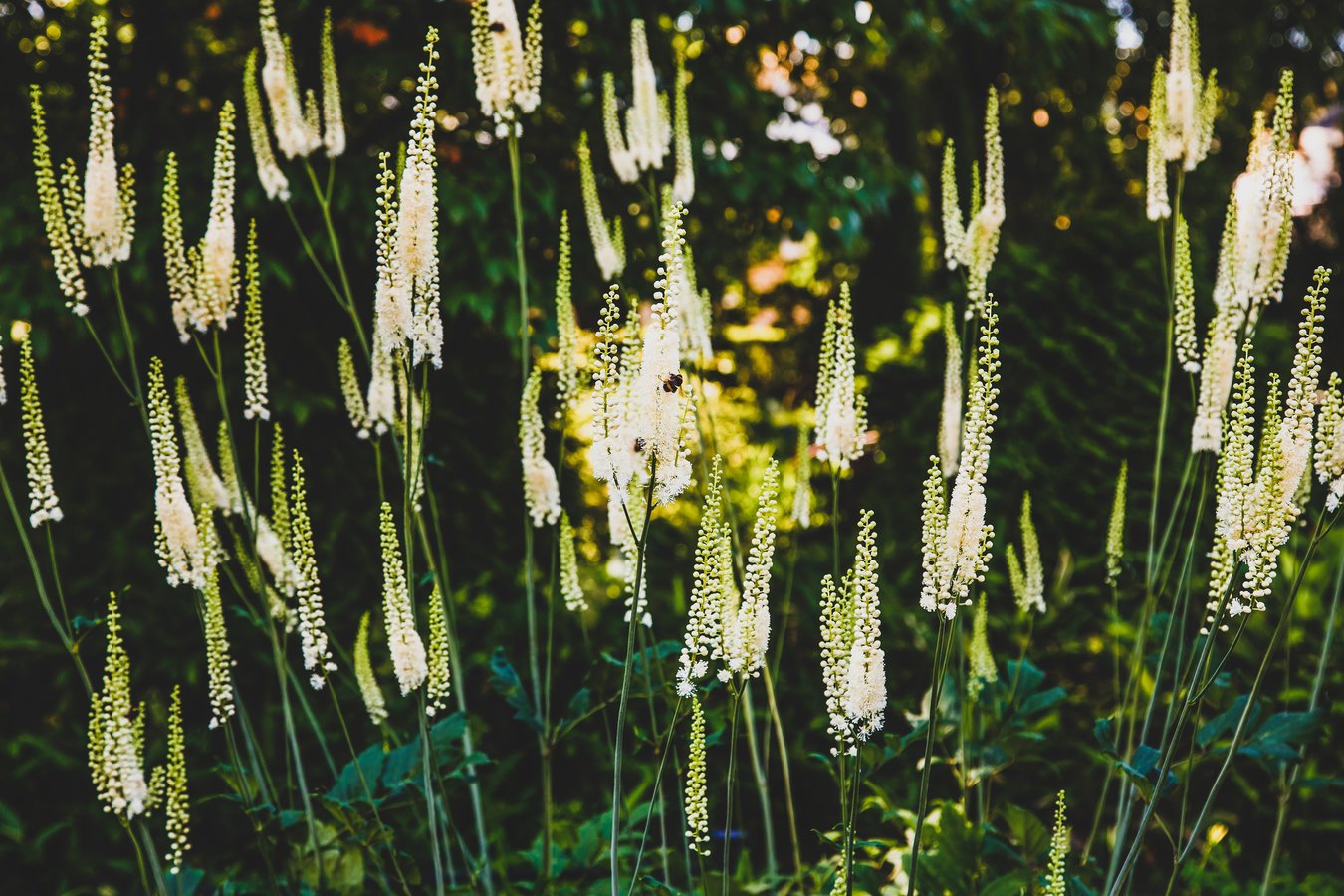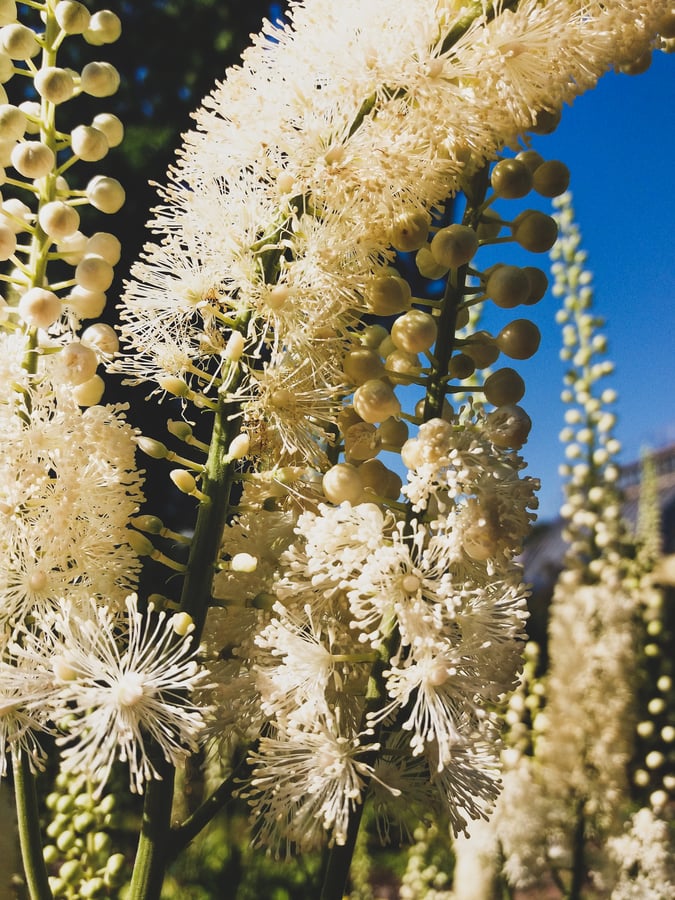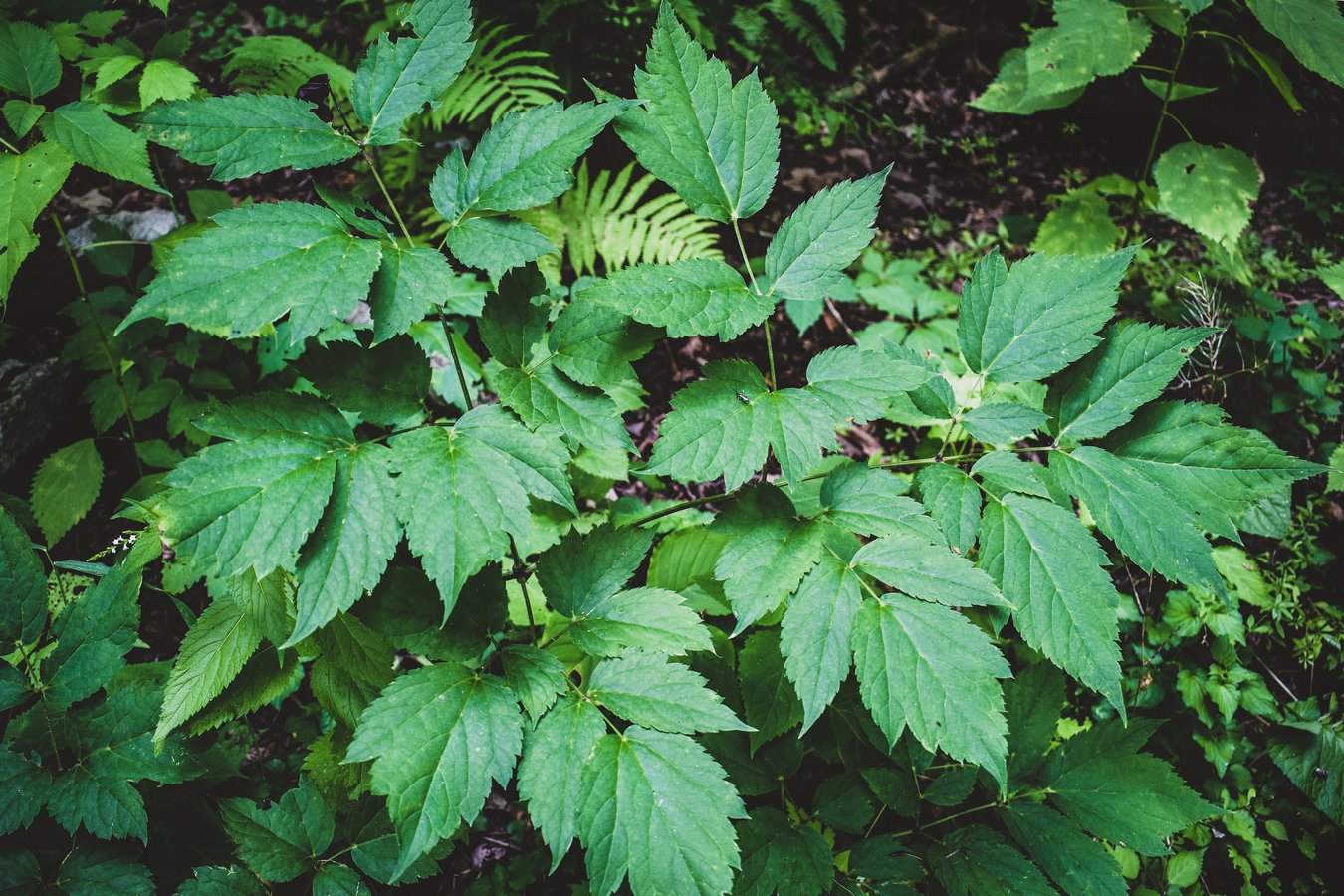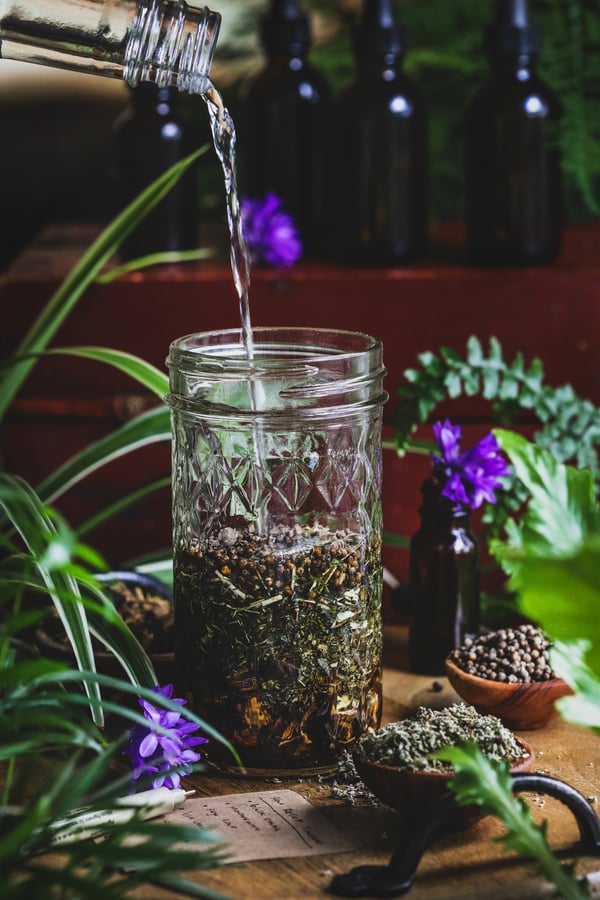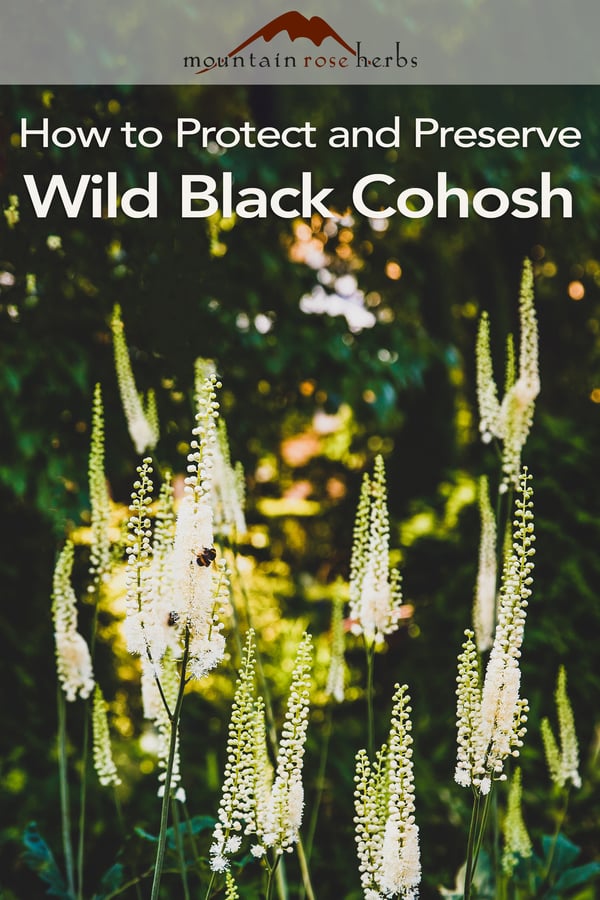Black cohosh (Actaea racemosa) is one of the top-selling herbal supplements in the United States. According to United Plant Savers (UpS), the harvest of black cohosh in our nation is as much as half-a-million pounds in dry weight per year—and 97% of that harvest is wild-sourced! This level of massive-scale wildharvesting has repercussions and raises concerns about the long-term sustainability of this powerhouse herb. Fortunately, unlike some of our other favorite forest-farmed botanicals, black cohosh is easy to cultivate. While this doesn’t address the immediate issue, it does give us hope for a bright future. Let’s take a deeper look at what we can do to support a sustainable future for black cohosh.
Black Cohosh: A Bit of Botany and a Little History
Black cohosh ranges along the East Coast of North America, from as far north as Ontario, Canada south to Georgia and Florida, and west to Indiana and Iowa. It loves the rich, moist soils in the understory of hardwood forests and can often be found on natural slopes and ravines. Black cohosh ranges in height from two to as much as eight feet. It is a dramatic summer bloomer, with big three-part, toothed leaves and tall florets of white flowers on long, towering stalks. To pollinate, it emits a strong, fetid aroma when it blooms, which is attractive to a wide variety of insects. This brings flying visitors who, unbeknownst to them, pick up pollen on their bodies and inadvertently deliver it to other black cohosh as they move from one plant to the next.
The plants reproduce by both seed and spreading roots. The seeds ripen in mid-summer in capsule-like pods. In the autumn, they will rattle in the pod when shaken, which is a sign that they are ready for harvest. However, they require a warm period (late summer and early fall) followed by a cold period (winter) to germinate.
Black cohosh has a long history of use, especially in the Appalachian Mountains, where First Nations Peoples like the Algonquians, Cherokee, and Iroquois used it for everything from snake bites and bee stings, to skin issues, throat and lung problems, backaches, arthritis, and rheumatism, as well as issues with menstruation and menopause. By the 19th century, physicians in North America and Europe were exploring black cohosh for menstrual cramps and arthritis. Today, it is often used in herbal blends to support menopausal symptoms, especially for hot flashes and night sweats.
Is Black Cohosh Endangered?
UpS has placed black cohosh on its “At-Risk” list. In general, this means a plant may be doing okay in some areas of its natural range while being over-harvested in others. Specific to black cohosh, it is still considered abundant in some areas of the central and southern Appalachians. However, it is critically imperiled in Mississippi, Massachusetts, and Illinois, where it is listed by state agencies as an endangered species. It has also been identified as a priority for conservation by the American Herbal Products Association, the U.S. Forest Service, and the U.S. Fish and Wildlife Service because of overall population declines.
Some of the issues for black cohosh have to do with general habitat degradation in the eastern forests, but the overwhelming problem is the sheer amount of continuous wildharvesting for the herbal and medicinal plants industries. According to Nature Serve Explorer, which classifies black cohosh as “vulnerable,” products derived from the dried roots and rhizomes generate over 35 million dollars annually in retail sales. At this time, there are no significant sources of cultivated black cohosh, so the demand for this herbal ally falls almost entirely on the wild population.
There is also another issue that is worth noting in regard to wild-harvested black cohosh. Several plant species are easily mistaken for black cohosh, and wildharvesters inadvertently harvest and sell the wrong plant. Once harvested, it is almost impossible to see a difference in the roots and rhizomes. Responsible herbal companies must authenticate their black cohosh products through lab testing. At Mountain Rose Herbs, our Quality Control Lab has a robust identification program that serves as a model for others in the herbal industry. We test our botanicals using a variety of macroscopic, microscopic, and state-of-the-art High Performance Thin-Layer Chromatography testing to ensure authenticity. But some companies do not have adequate quality control programs to detect adulterants, and this creates a health risk as supplements may be cross-contaminated with other species. DNA sequencing used to analyze black cohosh supplements found that three out of seven capsules tested did not contain any black cohosh DNA, one supplement instead contained Actaea brachycarpa (a species native to China), and another contained only rice DNA.
Take Action to Help Black Cohosh
Ultimately, the path to a happy, sustainable future for black cohosh lies in organic cultivation. With this in mind, UpS launched their Forest Grown Verified Program (FGV) to support forest farmers and “create a third-party verification process for non-timber forest-grown products that are produced and harvested in a sustainable and legal manner.” The FGV program provides important growing and life cycle information on five plants: cohosh, ginseng, goldenseal, bloodroot, and ramps, and they hope to expand the program to other native forest herbs, including Solomon’s seal and wild yam.
Until cultivation becomes the norm, however, there is not enough cultivated black cohosh to meet demand and we continue to rely on wildharvesting. Therefore, it is imperative that we support sustainable wildharvesting. FGV certification is ideal, but not always possible at this time. So it is up to the consumer (that’s you and me) to pay attention to what we purchase. Take a few minutes to find out where and how your cohosh was harvested so you can rest assured that you are purchasing only sustainably harvested roots. At Mountain Rose Herbs, we purchase black cohosh that is sustainably harvested on private land and our herbal extract is made from FGV certified roots.
All of that said, the very best way to ensure you are supporting the future of healthy, sustainable black cohosh is to grow your own and/or support community growers! Black cohosh can be grown from either seeds or rhizome cuttings. It requires well-drained, moist soil and prefers full or partial shade, particularly the shade of hardwood trees, so it can often be successfully grown in raised beds in the woods (this is “woods cultivated” cohosh) or in raised beds under an artificial shade cover (this is called “shade grown”). You must make sure to add goodly amounts of compost and/or other organic material and it prefers a pH of 5-6. If you have a larger piece of wooded land in the right region, black cohosh can also be grown in a lower density, low-input method that mimics how it naturally grows in the wild (referred to as “wild simulated”). With enough moisture, it will tolerate more light and soil variations than some other forest-grown botanicals like ginseng or goldenseal.
We sell black cohosh seeds from our friends at Strictly Medicinal Seeds, and you can also purchase live black cohosh roots directly from them. However, we suggest you first look locally for roots or seeds from your area; these may have a distinct advantage over options ordered from other bioregions. You can learn more about growing black cohosh at the Forest Farming Community and UpS websites.
Black cohosh is a remarkable, resilient botanical that needs immediate attention in order to thrive across its traditional range. We know the answer is cultivation, but it’s going to take time and consumer demand for organic, cultivated options. We all have the power to impact the future of black cohosh.
Rosemary Gladstar’s Hot Flash Relief Tincture
Rosemary Gladstar's books are always a source of inspiration and this recipe for hot flash relief from her book Herbal Recipes for Vibrant Health.
Ingredients
- 2 parts cultivated or sustainably harvested organic black cohosh
- 2 parts organic motherwort
- 2 parts organic sage leaf
- 1 part organic blue vervain
- 1 part organic vitex berries
- 80-100 proof organic vodka, gin, or brandy
Simpler’s or “Folk” Method Directions
- Choose a sterilized, dry jar that is just large enough to hold all ingredients and enough alcohol to cover by 2-3 inches above herbs. Herbs may swell in size and must be completely submerged without a lot of airspace in the jar above the alcohol.
- Put herbs in jar by parts to fill about 1/2 - 3/4 full.
- Pour in alcohol to the neck of the jar to cover plants completely. You will want the alcohol to be 2-3 inches above the herbs.
- Cover with an airtight non-metal lid or place a piece of wax paper over the jar top if using a metal lid to keep alcohol from coming in contact with metal.
- Label jar with ingredients, alcohol used, and date.
- Store in dark, cool area and shake daily for 6-8 weeks.
- Strain tincture through fine cheesecloth. Squeeze to get all the herbal goodness from the herbs.
- Bottle in cobalt or amber bottles for long-term storage.
- Label bottles with ingredients, including alcohol used, and date.
Pro Tips:
- For more information about making tincutres, see our How to Make Herbal Tinctures blog.
- If you do not consume alcohol, this blend can also be made as an infusion.
- If you cannot find cultivated or sustainably harvested organic black cohosh, Rosemary recommends eliminating the black cohosh from this blend and doubling the organic vitex berries (2 parts instead of 1 part).
- This hot flash tincture blend can also be made with premade tinctures. Simply add each of the extracts in the ratios listed above. Mountain Rose Herbs also offers a house-made blend that has many of the same ingredients.
*You will notice that Mountain Rose Herbs is sometimes out of stock of black cohosh. This is a result of our unwavering commitment to only sourcing through sustainable methods. People, plants, and planet will always come before profit to us, and sometimes that means that certain precious botanicals will be out of stock until we can consciously and sustainable offer them.
Want to Learn More About Forest Farming?
Read Forest Farming: Supporting Plants & People with Sustainable Agroforestry
You may also enjoy:
- A Forest Grown Future for Pennsylvania's Precious Ginseng
- Endangered White Sage: Procuring Organic Cultivated Salvia Apiana
- Trillium: An Age-Old Ally That Needs our Help

